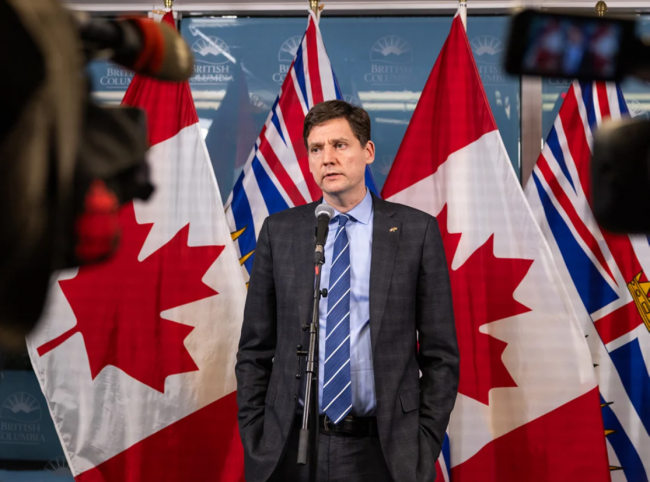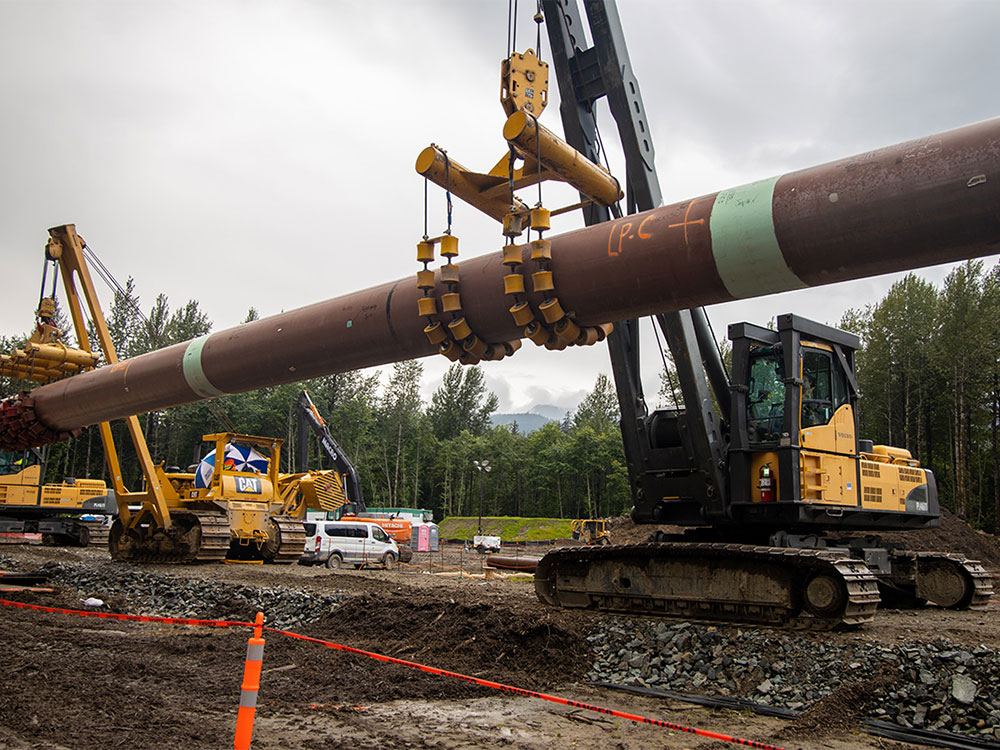Articles Menu

Feb. 10, 2025
It was a “profoundly awful and uncomfortable” few days, B.C. Premier David Eby told reporters last week.
The premier sounded sombre but resolute as he spoke about U.S. President Donald Trump’s flip-flop over tariffs against Canadian goods.
The tariffs, which were announced Feb. 1 and paused two days later, would have meant a 10 per cent tax on Canadian energy products such as oil, gas and electricity, and a 25 per cent tax on everything else.
Canada promised to retaliate. B.C. did, too. Last weekend, the province’s liquor stores briefly pulled spirits from Republican stronghold states off the shelves.
What hasn’t been paused are B.C.’s plans to fast-track at least 19 natural resource projects the province says are “close to shovel ready.” The projects represent $20 billion in investment and are expected to create 8,000 jobs, mainly in rural and remote communities, the premier’s office said. The province expects the list to grow as it continues to identify projects.
“Harm was done to the relationship between our countries and the stable business environment that we both count on,” Eby said at Monday’s news conference. “Having a diversified base of customers is good news for us and where we want to go.”
The United States is Canada’s biggest trading partner. Last year, it was the destination for more than 75 per cent of Canadian exports and the source of more than 62 per cent of our imports, according to Statistics Canada. In recent years, the annual combined value of Canadian goods crossing the U.S. border surpassed $1 trillion.
While experts The Tyee spoke with agreed that diversifying B.C.’s economy is important, they expressed concern about what fast-tracking these projects would mean for important steps such as environmental oversight and First Nations consultation.
Some were also skeptical about who would ultimately benefit.
The initial list of 19 projects is divided into three sections: critical minerals, energy security and clean energy. It includes mines, LNG and gas infrastructure, and electrical power projects. Among them are First Nations clean energy partnerships, including nine wind farms and one solar power project previously given the green light to bypass their environmental assessments.
Many projects on the premier’s list, such as the Indigenous-owned wind and solar projects, make sense to prioritize, said Kai Nagata, communications director for Dogwood BC, a non-profit focused on politics, energy and the environment. Nagata added that there’s also an argument to be made for copper mining that has First Nations consent.

But experts The Tyee spoke with cautioned that fast-tracking some megaprojects could do more to serve corporate interests than B.C. communities.
1. Fast-tracking comes with potential trade-offs
B.C.’s dependence on the United States as a trading partner leaves the province vulnerable to that country’s political fluctuations.
Resource industry advocates have long pushed for infrastructure developments, such as oil and gas pipelines, that would increase overseas exports and reduce dependence on the United States.
But large resource development projects also face opposition and increasing protest activity in B.C.
Werner Antweiler, an economics professor at the University of British Columbia’s Sauder School of Business, expressed concern that fast-tracking major resource projects could circumvent the province’s “robust environmental impact assessment process,” which considers environmental, social, economic, health and culture effects.
“The situation with the United States should not be taken as a pretext to short-circuit regulatory approval and oversight processes,” Antweiler told The Tyee. “If anyone is making the case for fast-tracking any resource projects, they should make clear what the trade-offs are.”
Antweiler added that any reduction in regulatory red tape should be made publicly and on the merits of each individual project.
Nagata agreed that the province’s plans would create jobs and revenue in the short term, but expressed concern about the long-term effects.
“Making the B.C. economy less dependent on any one country makes sense, but it would be a shame if that were to come at the expense of the clean water and the food security of Indigenous communities,” Nagata said.
The province has said that each of the projects on its fast-track list requires some type of permit or approval from government. But details on what fast-tracking might look like remain murky.
In an emailed statement, the premier’s office said the projects “will not skip permitting or consultations” and will still be required to undergo all approvals.
The projects “will be the focus of a senior deputy minister’s group from across critical sectors with a clear mandate to clear obstacles, drive decisions, and move projects forward quickly,” a spokesperson wrote.
“They’ll be focusing on reducing regulatory complexity with a focus on troubleshooting issues to support the selected major projects with significant potential to create jobs.”
2. Some projects involve US ownership and investment
B.C. is heavily dependent on foreign investment. The province ranks third in Canada, behind Ontario and Quebec, for employment from foreign national enterprises, and U.S.-owned firms account for two-thirds of employment from those foreign corporations, according to a report released in November by Invest Vancouver.
Among the projects B.C. intends to expedite are the Red Chris mine expansion and the proposed Eskay Creek mine, both located in northwest B.C.’s “Golden Triangle.”
Red Chris is owned by Newmont Corp., a Colorado-based gold-mining giant, while Eskay Creek is owned by Skeena Resources, which, in addition to some investment from the Tahltan Nation, is majority owned by a group of U.S. investors.
“You look at the top shareholders of any of these publicly traded mining companies and it’s these asset managers in the States. It’s very hard to get away from American capital, especially in the natural resource sector,” Nagata said.
When asked whether it had considered U.S. ownership when identifying projects to expedite, the premier’s office said it was “focused on projects that create good paying jobs in B.C. that can help support families.”
“In principle, there is nothing wrong with foreign ownership that meets the standards of the Investment Canada Act,” Antweiler told The Tyee, adding that, in the long run, Canadian and U.S. interests align on many issues.
“Even with Trump at the helm in the U.S., infuriating and frustrating as that may be, I don’t see the U.S. as our adversary,” he said. “Oftentimes, U.S. partners bring much-needed capital to the table to build up Canadian ventures.”
Among the biggest multinational corporations with interests in rural and remote B.C. are those developing fossil fuel infrastructure to ship gas through pipelines and liquefy it at coastal facilities for overseas export. Several LNG projects are currently moving through the provincial approval process. Their ownership ranges from First Nations to Asian to U.S.
Only one of the province’s proposed LNG projects made the premier’s list of projects to expedite. Cedar LNG, a partnership between the Haisla Nation and Calgary-based Pembina Pipeline Corp., already has provincial approval but has applied for amendments to its environmental assessment certificate.

Pembina has partnered on joint ventures and merged some assets in Western Canada with U.S. investment firm KKR, whose co-founder Henry Kravis was floated by Trump as a possible pick for treasury secretary in his first administration.
It’s unclear if KKR has a direct stake in Cedar LNG, Nagata said.
One of the other projects on Eby’s list, the 450-kilometre North Coast Transmission Line, could signal provincial support for further expanding LNG.
Listed under “clean energy” alongside wind and solar projects B.C. would like to fast-track, the North Coast Transmission Line would bring increased electrical capacity to B.C.’s north coast, something required for the LNG industry to expand under B.C.’s current climate goals. (Eby had previously announced that the province would waive the transmission line’s environmental assessment, a decision that followed heavy lobbying from the LNG industry.)
The premier’s office said the North Coast Transmission Line “is not for any single industry” and that industrial expansion on the north coast, including ports, mining, LNG and hydrogen, is driving demand for electricity.
But among those most anxious for an upgraded power supply is Texas-based Western LNG, which lobbied the province dozens of times last year on climate policy, electrification and the North Coast Transmission Line. The company owns both the Prince Rupert Gas Transmission line — a partnership with the Nisga’a Nation — and the adjoining Ksi Lisims LNG export terminal. Both are currently awaiting provincial authorizations, and neither appears on the province’s current list of expedited projects.
In December, Western LNG announced significant investment in the projects by Blackstone, a U.S. energy investment company headed by longtime Trump adviser Stephen Schwarzman, who backed the president’s recent election campaign.
3. Some projects may not be as ‘green’ as they first appear
While B.C.’s list highlights energy security, clean energy and critical minerals — meaning materials required in the transition to renewable energy — in some cases the headings stretch their definitions, said Nikki Skuce, director of Northern Confluence and co-chair of the BC Mining Law Reform network.
When it comes to “critical minerals,” the province has previously pointed to metals such as copper, nickel and molybdenum — which are essential for the production of things like electric vehicles, solar panels and wind turbines — as priorities in shifting to a greener economy.
Skuce called it “disingenuous” to include gold-mining projects like Eskay Creek, which is currently undergoing its environmental assessment to build a silver-gold mine in northern B.C., as critical to B.C.’s energy transition.
“Neither gold nor silver are critical minerals. They are used entirely for currency valuation and jewelry,” she said. “There’s nothing ‘critical’ about them.”
The rush to develop gold resources may instead have more to do with the precious metal’s value reaching an all-time high this week, Nagata said.
“All of the investors who are trying to get these big gold projects off the ground are all licking their lips because of the financial instability created by Trump,” he said. “That’s driving demand for gold and creating justification for large gold mines, even if it doesn’t provide critical minerals necessary for the renewable energy transition.”
Three other mines on the list — Highland Valley Copper, Red Chris and Mount Milligan — are seeking permit approvals to expand their operations. All three produce copper, a metal used in electrical wiring, along with other minerals, like gold and molybdenum.
When it comes to diversifying the economy and hiring in rural areas, Skuce said that most of the ore is processed overseas and it isn’t easy to track the end use of the minerals. The province also doesn’t sufficiently track employment, she said, so it’s difficult to pinpoint how many local workers benefit.
At least one project on the province’s list, the Highland Valley Copper mine’s proposed expansion, faces First Nations opposition. In November, the Stk’emlúpsemc te Secwépemc Nation issued a statement saying it had not given consent for the expansion.
Another project on the list, NorthRiver Midstream’s NEBC Connector, was stalled by the Yahey v. B.C. court decision, which found that cumulative effects from industrial development had impacted the Blueberry River First Nations’ treaty rights.
On Thursday, the First Nations Leadership Council issued a statement denouncing Trump’s tariff threats and demanding that B.C.’s response “respect and uphold the inherent and constitutionally protected title and rights and jurisdictions of First Nations.”
4. It’s unclear how the projects will assist with B.C.’s ‘energy security’
The NEBC Connector, which proposes to build pipelines connecting northeast B.C.’s gas reserves to Alberta for use in the oilsands, is listed under “energy security” alongside Cedar LNG and Enbridge’s T-North Aspen Point project.
But it’s questionable how much the expansion of gas infrastructure would benefit B.C. residents, Nagata said.
“The whole idea of energy security is a bit misleading,” said Nagata. “It’s not that demand in B.C. is going up. In fact, demand all over the western world is plateauing or going down for gas. It’s about trying to export more LNG.”

When asked how the projects would contribute to B.C.’s energy security, the premier’s office pointed to the T-North Aspen Point expansion, saying it would serve a domestic market and “link up energy delivery to the Lower Mainland.”
Enbridge has said the project would “serve growing regional demand for natural gas and potential west coast LNG exports.”
But B.C. currently uses less than 10 per cent of the gas it produces. The province’s residential portion of that is about three per cent of overall production — and falling.
Nagata fears that pushing ahead with unnecessary oil and gas development could shift the financial burden to B.C. ratepayers while the profits flow back to “some of the billionaires who are closest to Trump and the MAGA project.”
“We need to be careful that we’re not inadvertently cementing the power of American fossil capital and Wall Street private equity firms in B.C.,” Nagata said.
[Top photo: BC Premier David Eby has promised to ‘expedite’ 19 natural resource projects in the face of a possible trade war with the United States. Photo via BC government Flickr.]